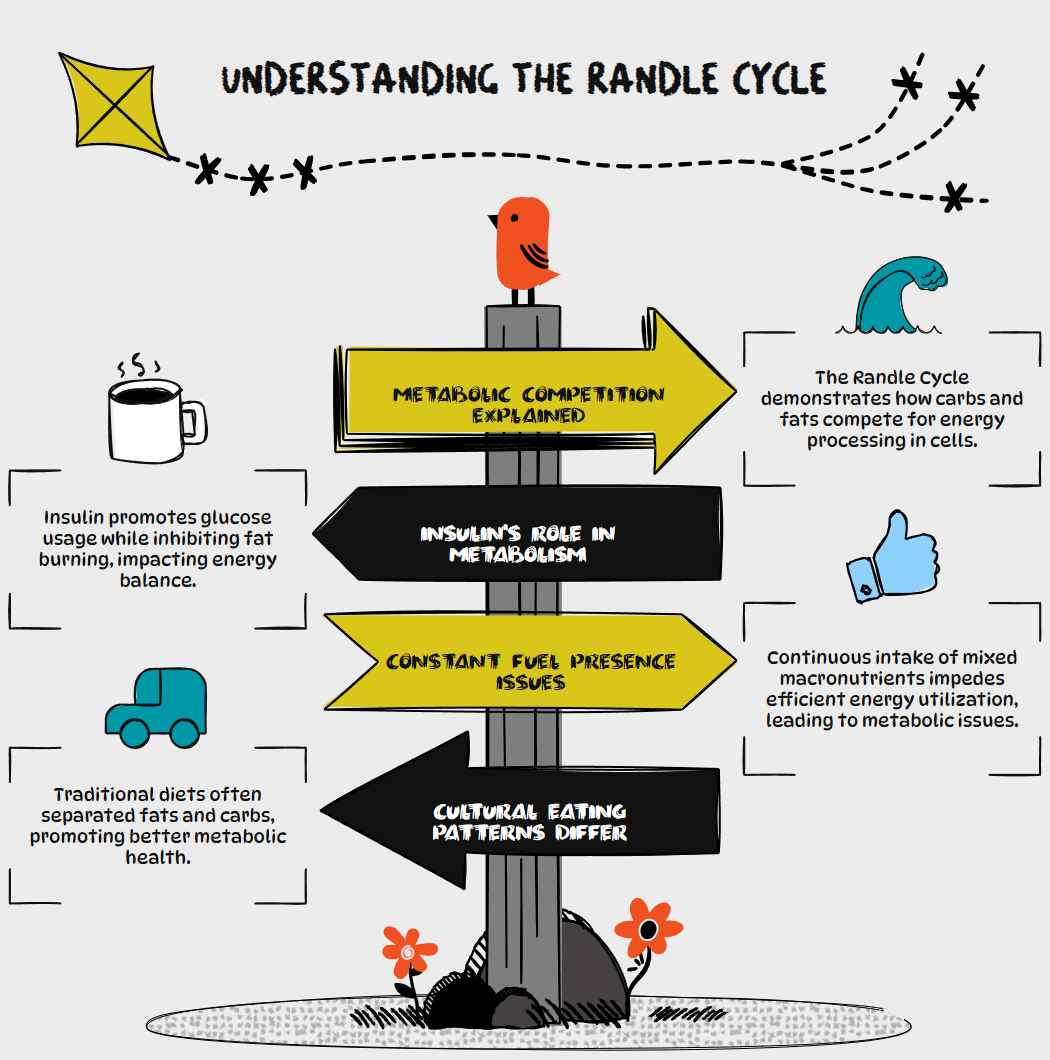
The Randle Cycle Reveals Why Your Mixed Diet May Be Sabotaging Your Metabolism
The Randle Cycle Reveals Why Your Mixed Diet May Be Sabotaging Your Metabolism
Your body speaks a language of metabolic priorities. When you consume carbohydrates and fats together, an ancient biological mechanism that most nutrition experts rarely discuss kicks in. This mechanism, known as the Randle Cycle, helps explain why the standard Western diet might be fundamentally flawed at a cellular level.
The science of metabolism isn't just academic theory. It's the foundation of how our bodies process energy, and understanding it could transform how we think about nutrition, weight management, and metabolic health.
What Is the Randle Cycle
The Randle Cycle, named after physiologist Philip Randle, who discovered it in the 1960s, describes the competitive relationship between carbohydrates and fats in our metabolic system. When both nutrients are present in significant amounts, they compete for oxidation in our cells.
Here's what happens: When you consume carbohydrates, your pancreas releases insulin, which drives glucose into cells and simultaneously inhibits fat burning. The body prefers to burn glucose and stores dietary fat. This isn't a design flaw but an evolutionary adaptation that helped our ancestors survive food scarcity by storing energy efficiently.
The problem arises when we consistently consume both macronutrients together in every meal. The body never entirely shifts to efficient fat metabolism because it's constantly processing glucose.
The Metabolic Competition
The process is fascinating at a biochemical level. Glucose metabolism produces acetyl-CoA, which inhibits the transport of fatty acids into the mitochondria, where they would otherwise be burned for energy. Simultaneously, the breakdown products of fatty acid metabolism inhibit key enzymes in the glucose metabolism pathway.
This creates a situation where neither fuel source is utilized optimally. It's like trying to burn wood and coal in a fireplace simultaneously. Each interferes with the efficient burning of the other.
Insulin from regular carbohydrate consumption keeps the body in a primarily glucose-burning state, while dietary fats are continuously directed into storage. Over time, this can lead to insulin resistance, metabolic inflexibility, and impaired energy production.
Modern Diets and Metabolic Disruption
Look at the standard Western plate: a protein source, starchy carbohydrates, and added fats. This combination appears in countless forms, from burgers with fries to pasta with cream sauce. We've been conditioned to believe this represents dietary balance, but from a metabolic perspective, it creates constant fuel competition.
Contrast this with traditional eating patterns from around the world before the globalization of food. Many cultures naturally separated their fat and carbohydrate consumption by meal timing or season. They weren't aware of the Randle Cycle, but their eating patterns often aligned better with our metabolic machinery.
Continuous consumption of mixed macronutrient meals throughout the day never fully allows the body to transition between metabolic states. This metabolic inflexibility may contribute to the rising rates of obesity, diabetes, and other metabolic disorders.
Metabolic Flexibility as the Goal
The solution isn't necessarily eliminating either carbohydrates or fats permanently. Instead, it's about understanding how to work with your metabolism instead of against it.
Metabolic flexibility refers to the body's ability to switch between different fuel sources based on availability and activity demands. A metabolically flexible person can efficiently burn carbohydrates when consumed and seamlessly transition to burning fat when carbohydrates aren't available.
This flexibility appears to be compromised in individuals with insulin resistance, obesity, and metabolic syndrome. The constant mixing of fuels may contribute to this loss of metabolic adaptability.
Practical Applications
Understanding the Randle Cycle doesn't necessarily mean adopting extreme dietary approaches, but it does suggest some potential strategies worth considering:
First, consider the temporal separation of macronutrients. This could mean focusing some meals on protein and carbohydrates while keeping fat lower, and other meals on protein and fat while maintaining minimal carbohydrates.
Second, intermittent fasting or time-restricted eating may help by creating periods where insulin levels drop sufficiently to allow complete switching to fat metabolism.
Third, physical activity, particularly strength training and high-intensity exercise, can improve metabolic flexibility by increasing muscle glycogen storage capacity and enhancing fat oxidation pathways.
Fourth, quality matters tremendously. Not all carbohydrates affect insulin the same way, and not all fats have identical metabolic effects. Focusing on whole, unprocessed foods gives the body the nutrients it needs to maintain metabolic health.
Beyond Dogma
The nutrition world is often polarized between low-fat and low-carb camps. The Randle Cycle suggests that both approaches might work, not because one macronutrient is inherently "bad," but because both approaches reduce the metabolic competition when carbs and fats are consistently consumed together.
This perspective shifts the conversation from demonizing specific macronutrients to understanding how they interact in our bodies. It's not about finding the perfect diet for everyone, but recognizing the fundamental metabolic principles that might guide individual nutritional choices.
The science of metabolism continues to evolve, but the Randle Cycle provides a compelling framework for understanding why our modern eating patterns might contribute to widespread metabolic dysfunction. By respecting these biological mechanisms rather than fighting against them, we may find more sustainable approaches to nutrition that support long-term metabolic health.
When we align our eating patterns with our metabolic physiology, we create the conditions for optimal energy production, weight management, and overall health. The Randle Cycle isn't just an academic concept. It's a key to unlocking a more nuanced understanding of how food affects our bodies at the most fundamental level.
